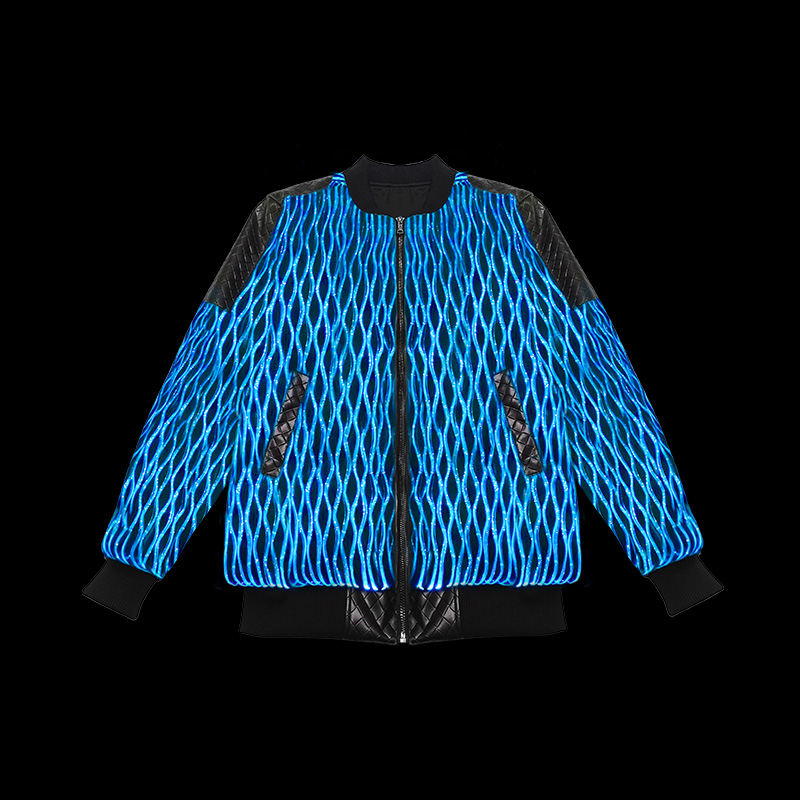As a textile technologist specializing in photonic integration, I’ve spent years studying how light interacts with fabric at a fundamental level. The evolution of mens EDM festival clothing represents one of the most exciting developments in wearable technology today. This isn’t just fashion—it’s functional art that bridges the gap between personal expression and technological innovation.
When we examine clothes rave through a technical lens, we’re really looking at the marriage of three distinct disciplines: textile engineering, illumination technology, and human kinetics. The best pieces succeed because they honor all three elements equally.
The hoodie with lights category demonstrates this balance beautifully. Superior designs use woven fiber optics rather than attached LEDs, creating illumination that appears to emanate from the fabric itself. The difference is both visual and tactile—these garments move with the body rather than against it, creating organic light patterns that respond naturally to movement.
In evaluating jacket LED light systems, I apply rigorous technical criteria:
- Circuit integrity: Flexible printed circuits that withstand repeated movement
- Power efficiency: LED arrays that provide maximum luminosity with minimal energy consumption
- Thermal management: Heat dissipation systems that prevent damage to both electronics and fabric
- Interface design: Intuitive control systems that enhance rather than complicate the user experience
The light up vest represents perhaps the most practical application of this technology. As a layering piece, it offers versatility while providing impressive visual impact. The best designs use strategic placement of illumination to create depth and dimension, often employing different lighting zones that can be controlled independently.
What many enthusiasts don’t realize about quality jacket led systems is the sophistication of their construction.
Truly professional-grade pieces feature:
- Modular component design for easy repair and upgrading
- Environmental sealing that protects electronics from moisture and dust
- Weight distribution systems that balance battery placement with comfort
- Adaptive lighting systems that respond to both sound and movement
The led hoodie has evolved significantly from its early iterations.
Contemporary examples showcase:
- Machine-washable designs (with proper component removal)
- Wireless charging capabilities
- Micro-LED technology for finer resolution patterns
- Smart sensors that adjust output based on ambient conditions
From my professional perspective, the future of mens light up rave clothing lies in smarter systems that can:
- Communicate with other garments to create coordinated light shows
- Harvest energy from movement to extend battery life
- Incorporate biometric sensors that translate physiological responses into visual patterns
- Utilize sustainable materials that reduce environmental impact
Technical Care Protocol:
Maintaining these sophisticated garments requires understanding both their textile and electronic components:
1.Pre-Cleaning Preparation
- Remove all power sources and control modules
- Seal electrical connectors with protective caps
- Secure loose wiring with provided fasteners
2.Cleaning Process
- Hand wash in cold water (<30°C/86°F)
- Use pH-neutral detergent only
- Avoid abrasive scrubbing or twisting
- Rinse thoroughly to remove all soap residue
3.Drying and Storage
- Lay flat on moisture-wicking surface
- Avoid direct heat or sunlight
- Store components in anti-static packaging
- Maintain batteries at 40-60% charge for storage
4.Electronic Maintenance
- Clean contacts quarterly with isopropyl alcohol
- Update firmware when available
- Inspect wiring regularly for wear or damage
- Store in climate-controlled environment
5.Long-Term Preservation
- Rotate garments to prevent LED degradation
- Use silica gel packets to control moisture
- Avoid compression storage that might damage components
The true beauty of these garments lies in their ability to transform the wearer from spectator to performer, creating dynamic visual narratives that evolve with the music. As the technology advances, we’re moving toward clothing that doesn’t just reflect light but communicates, responds to, and even generates its own visual language.

